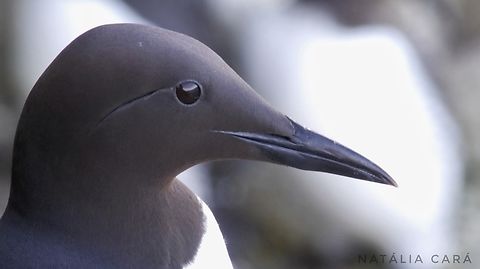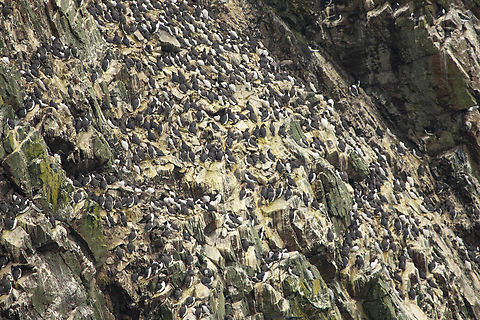
Appearance
The Common Murre is 38–46 cm in length with a 61–73 cm wingspan. Male and female are indistinguishable in the field and weight ranges between 945 g in the south of their range to 1044 g in the north. A weight range of 775–1,250 g has been reported. In breeding plumage, the nominate subspecies is black on the head, back and wings, and has white underparts. It has thin dark pointed bill and a small rounded dark tail. After the pre-basic moult, the face is white with a dark spur behind the eye. Birds of the subspecies "U. a. albionis" are dark brown rather than black, most obviously so in colonies in southern Britain. Legs are grey and the bill is dark grey. Occasionally, adults are seen with yellow/grey legs. In May 2008, an aberrant adult was photographed with a bright yellow bill.The plumage of first winter birds is the same as the adult basic plumage. However, the first pre-alternate moult occurs later in the year. The adult pre-alternate moult is December - February,. First year birds can be in basic plumage as late as May, and their alternate plumage can retain some white feathers around the throat.
Some individuals in the North Atlantic, known as "bridled guillemots", have a white ring around the eye extending back as a white line. This is not a distinct subspecies, but a polymorphism which becomes more common the farther north the birds breed - perhaps character displacement with the northerly Thick-billed Murre, which has a white bill-stripe but no bridled morph. The white is highly contrasting especially in the latter species and would provide an easy means for an individual bird to recognize conspecifics in densely-packed breeding colonies.
The chicks are downy with blackish feathers on top and white below. By 12 days old, contour feathers are well developed in areas except for the head. At 15 days, facial feathers show the dark eyestripe against the white throat and cheek.
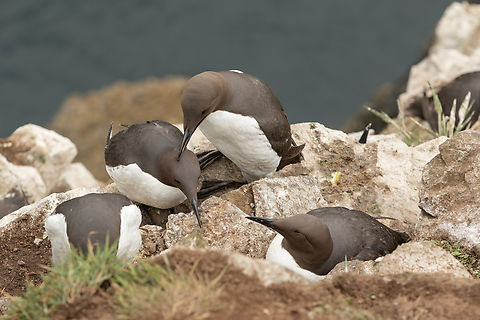
Distribution
Some birds are permanent residents; northern birds migrate south to open waters near New England, southern California, Japan, Korea and the western Mediterranean. Common Murres rest on the water in the winter and this may have consequences for their metabolism. In the Black-legged Kittiwake resting metabolism is 40% higher on water than it is in air.The population is large, perhaps 7.3 million breeding pairs or 18 million individuals. It is presently stable, but potential threats include excessive hunting, pollution and oil spills.
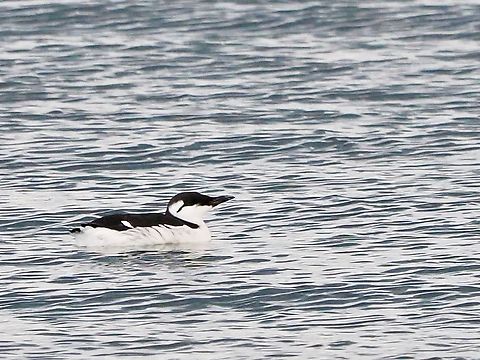
Reproduction
Common Murre eggs are large, and are pointed at one end. There are a few theories to explain their pyriform shape:# If disturbed, they roll in a circle rather than fall off the ledge.
# The shape allows efficient heat transfer during incubation.
# As a compromise between large egg size and small cross-section. Large size allows quick development of the chick. Small cross-sectional area allows the adult bird to have a small cross-section and therefore reduce drag when swimming.
Eggs are laid between May and July for the Atlantic populations and March to July for those in the Pacific. The female spends less time ashore during the two weeks before laying. When laying, she assumes a "phoenix-like" posture: her body raised upright on vertical tarsi; wings half out-stretched. The egg emerges point first and laying usually takes 5–10 minutes.
The eggs vary in colour and pattern to help the parents recognize them, each egg's pattern being unique. Colours include white, green, blue or brown with spots or speckles in black or lilac. After laying, the female will look at the egg before starting the first incubation shift. Both parents incubate the egg for the 28 to 34 days to hatching in shifts of 1–38 hours.
Eggs can be lost due to predation or carelessness. Crows and Gulls are opportunist egg thieves. Eggs are also knocked from ledges during fights. If the first egg is lost, the female may lay a second egg. This egg is usually lighter than the first, with a lighter yolk. Chicks from second eggs grow quicker than those from first eggs. However this rapid growth comes at a cost, first chicks have larger fat reserves and can withstand temporary shortages of food.
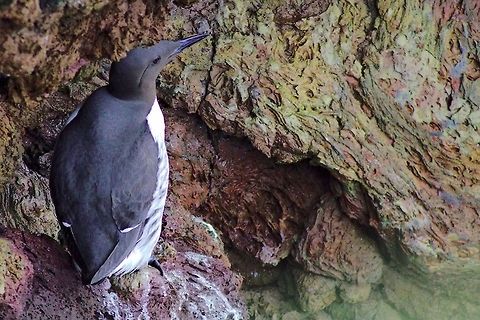
Food
The Common Murre can venture far from its breeding grounds to forage; distances of 100 km and more are often observed though if sufficient food is available closer by, birds only travel much shorter distances. The Common Murre mainly eats small schooling forage fish 200 mm long or less, such as polar cod, capelin, sand lances, sprats, sandeels, Atlantic cod and Atlantic herring. Capelin and sand lances are favourite food, but what the main prey is at any one time depends much on what is available in quantity. It also eats some molluscs, marine worms, squid, and crustaceans such as amphipods. It consumes 20-32 grams of food in a day on average. It is often seen carrying fish in its bill with the tail hanging out.The Snake Pipefish is occasionally eaten, but it has poor nutritional value. The amount of these fish is increasing in the Common Murre's diet. Since 2003, the Snake Pipefish has increased in numbers in the North-east Atlantic and North Sea and sandeel numbers have declined.In areas such as Newfoundland, the birds, along with the related Thick-billed Murre, are referred to as 'turrs' or 'tuirs', and are consumed. The meat is dark and quite oily, due to the birds' diet of fish. Eggs have also been harvested. Eggers from San Francisco took almost half a million eggs a year from the Farallon Islands in the mid-19th century to feed the growing city.
References:
Some text fragments are auto parsed from Wikipedia.
